Nicaragua: It Was Not Revolution, It Was Dictatorship

“I believe that the massacre of 2018 and all the crimes that are being committed in Nicaragua come from the lie that has been lived since 1979”
By Francisco Larios (Confidencial)
HAVANA TIMES – I don’t know with what words, or with how many amplifying speakers, e-mail messages, publicity posters, prayers or pleads, recommend “Tying up loose ends between totalitarianisms” by the magnificent painter and writer Otto Aguilar.
My motivation is this: I believe that the massacre of 2018 and all the crimes that are being committed in Nicaragua come from the lie that has been lived since 1979, year in which we thought that we touched the sky with our hands, and in a blind ecstasy we allowed a gang not fit for power to accumulate it excessively.
I know that it is painful for many, still, at this stage, to face this brutal reality. Many of those who today oppose Ortega-Murillo, and are even its victims, were part of the movement, as well as a huge number of people who at the time acted on principle and decency.
Many of them cried, and I do not say that figuratively, when the FSLN dictatorship fell defeated in 1990. It took them years, after that defeat, to break completely with the mother tree.
Later they have tried, instead of facing the truth, to create another myth, that of “before the piñata, the idealist revolution and its conquests; after the piñata, [the massive appropriation of public properties and other assets during the transition period of Feb. 25 to April 25, 1990] the kidnapping of the party and degeneration.”
But the evidence that has accumulated for more than 30 years is overwhelming, and should force them to return to the lost road, not only for them, but at some point for all of us: the path of truth.
To begin with, the “Sandinista Revolution” has to be enclosed in quotation marks and then the keys thrown to the garbage.
It is certainly true, that there was a popular insurrection against the dictatorship, also genocidal, of the Somozas. The rebellion was full of heroism and despair, and a passionate desire to build a utopian future.
Then they arrived, the usual ones, the foxes of power.
In such a way that there were guillotines and privileges for some under the revolution. Of equality, fraternity and liberty, very little. A lot of Hollywood and Bollywood, a lot of revolutionary tourism, pose and Machiavellian’s media, while much torture, robbery, crime; and the rest, the same of all our previous history.
If before they were hacienda peons, the cannon fodder of oligarchs and caudillos, during the dictatorship of the FSLN (this goes without quotation marks) such misfortune happened to a whole generation of young people, kidnapped by the totalitarian State and used as pieces in their bloody chess game. That’s why I found the book “Perra Vida” (A dog’s life), the adolescent memoires of writer Juan Sobalvarro, impressive, in which he beautifully recounts, from his own experience as a recruit, what the boys at that time, who could not avoid conscription, lived.
That is why I repeat my message to the translators and communicators of history who still cling to the myth of the “Sandinista Revolution”: the most revolutionary thing they could do, the bravest, the most beautiful inheritance, the one that can change history for good (not “revise it”) is to denounce the root of the tragedy: to have let the tree to grow crooked from the beginning, despite having been watered so generously by so many.





